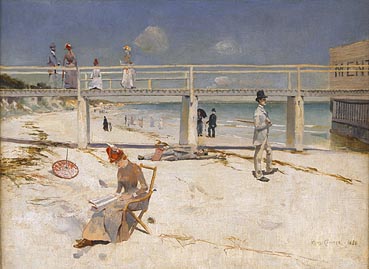
Amongst those who created the Heidelberg school in Australia, Roberts brought it intellectual rigour, McCubbin poetic nostalgia, and Streeton unbridled confidence. Charles Conder gave it wings of imagination. Soon after the school had reached its zenith, he left for Europe. There, brilliant of vision, flawed in lifestyle, he became one of the legendary figures of the fin de si�cle. But it was in Australia where his painterly language was formed. Here, in its landscape, we may find the birth of his genius and understand the remarkable and diverse journey it took over two short decades.
Barry Pearce, Head Curator of Australian Art and Co-Curator of the Charles Conder Retrospective
Frederick McCubbin, Tom Roberts, Arthur Streeton and Charles Conder are considered to have laid the foundation of the great Heidelberg school of impressionism of the late nineteenth century in Australia, and in doing so created the first truly national school of Australian painting. Of this celebrated group, Conder is without doubt the most enigmatic, the most charming, the most bohemian, and the only one to go on to become a legendary figure of the international art world of Paris and London.
The Charles Conder Retrospective includes 112 paintings, watercolours on silk, drawings and prints, tracking the artist's Australian period through his famous Heidelberg images, to his inspiring years in Paris where as an habitu� of the Moulin Rouge he became close friends with such luminaries as Toulouse-Lautrec and Anquetin, and in England and France where he counted Aubrey Beardsley, Oscar Wilde and Ernest Dowson amongst his intimates.
The works of art in this exhibition have been drawn from public and private collections throughout Australia and Britain, including Tate Britain and the National Portrait Gallery in London, many not seen by the public for half a century or more. Outstanding of these is a two-metre high silk painting from the Victoria and Albert Museum, London, perhaps the most beautiful and spectacular of its kind and period by any artist in Europe.
Charles Conder is the only one of his essential Australian circle for whom no major retrospective has been organised. The reason is simple; he was here for only a brief six years. A large part of his output is in the public collections of England, rarely seen by Australians who have merely glimpsed the finest of his other-worldly visions in poor reproduction; restricted in their appreciation mainly to a core of jewel-like landscapes made on the Hawkesbury River, Sydney Harbour, and the painting sites around Melbourne between 1886 and 1890.
At last this long overdue retrospective is taking place, fittingly organised by the Art Gallery of New South Wales, because Sydney is where the young artist began his career. In 1884 fifteen-year-old Conder arrived here, sent from England to be apprenticed to his uncle as a trainee surveyor. Soon he was on his own, supplementing a painting career with work as an illustrator.
In 1888 a meeting with Tom Roberts in Mosman lured him to the painting camps of Melbourne where, shortly after his arrival he visited Mentone and Box Hill. In the following year he took up residence at the abandoned Eaglemont homestead, in idyllic countryside on the north-east fringe of the city, and with Roberts and Streeton brought to its fullest notoriety that incandescent movement now called the Heidelberg school. In 1890 he left Australia for Europe and never returned, dying in England of venereal disease less than two decades later, just past his fortieth birthday.
The Charles Conder Retrospective will be a revelation both in its rare gathering of Conders visions of the Australian landscape, and many European works, which have never been shown in this country; including plein air landscapes, silk paintings, fans, book designs and a decorated dress which is one of the treasures of the costume collection of the Victoria & Albert Museum.
The curators of the Retrospective are Dr Ann Galbally of the University of Melbourne, and Barry Pearce, Head Curator of Australian Art at the Art Gallery of New South Wales. The catalogue will be a definitive picture book on the artist, complementing the recently published biography by Dr Galbally. Writers for the catalogue include the two curators, as well as Barry Humphries, passionate Conder collector and lender to the exhibition.
EXHIBITION EVENTS
ART AFTER HOURS
The Charles Conder Retrospective exhibition will be accompanied by a range of public programmes, the most innovative and popular of which is sure to be the series of free events planned for 'Art After Hours' at the Gallery on Wednesday evenings between the 9 July and 13 August. This series including music, poetry and film offers fresh and unexpected perspectives on Conder's bohemian life and artistic reputation.
STUDY DAY
An Art Gallery Study Day devoted to the Conder exhibition on Saturday 21 June will feature in-depth analysis of the artist�s achievements and behind-the-scenes accounts from a range of art experts, curators, historians and conservators, all intimately involved in shaping the scope and direction of the current exhibition.
FILM PROGRAMME
A lively film programme is scheduled with rare screenings of feature films on 35mm imported direct from Paris including Jean Renoir's French Can-Can and Roger Planchon's film Lautrec, as well as John Huston's original version of Moulin Rouge.
GUIDED TOURS
Free guided tours will take place in the exhibition twice daily and a Friday lunchtime lecture series planned to provide a further context for understanding Conder's artistic vision and reputation alongside that of his friends and colleagues in the Gallery's Australian collections.
EDUCATION KIT
An education kit for schools with a website extension and holiday programmes for children will cater to younger audiences.
Sponsored by Art Gallery of New South Wales President's Council
TOURING DATES
Art Gallery of New South Wales
14 June to 17 August 2003
National Gallery of Victoria
6 September to 9 November 2003
Art Gallery of South Australia
21 November 2003 to 26 January 2004
The exhibition at the Art Gallery of South Australia will consist of 65 of the 11
|